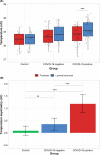Diagnostic accuracy of infrared thermal imaging for detecting COVID-19 infection in minimally symptomatic patients
- PMID: 33336385
- PMCID: PMC7883263
- DOI: 10.1111/eci.13474
Diagnostic accuracy of infrared thermal imaging for detecting COVID-19 infection in minimally symptomatic patients
Abstract
Introduction: Despite being widely used as a screening tool, a rigorous scientific evaluation of infrared thermography for the diagnosis of minimally symptomatic patients suspected of having COVID-19 infection has not been performed.
Methods: A consecutive sample of 60 adult individuals with a history of close contact with COVID-19 infected individuals and mild respiratory symptoms for less than 7 days and 20 confirmed COVID-19 negative healthy volunteers were enrolled in the study. Infrared thermograms of the face were obtained with a mobile camera, and RT-PCR was used as the reference standard test to diagnose COVID-19 infection. Temperature values and distribution of the face of healthy volunteers and patients with and without COVID-19 infection were then compared.
Results: Thirty-four patients had an RT-PCR confirmed diagnosis of COVID-19 and 26 had negative test results. The temperature asymmetry between the lacrimal caruncles and the forehead was significantly higher in COVID-19 positive individuals. Through a random forest analysis, a cut-off value of 0.55°C was found to discriminate with an 82% accuracy between patients with and without COVID-19 confirmed infection.
Conclusions: Among adults with a history of COVID-19 exposure and mild respiratory symptoms, a temperature asymmetry of ≥ 0.55°C between the lacrimal caruncle and the forehead is highly suggestive of COVID-19 infection. This finding questions the widespread use of the measurement of absolute temperature values of the forehead as a COVID-19 screening tool.
Keywords: COVID-19; diagnosis; machine learning; screening; thermography.
© 2020 Stichting European Society for Clinical Investigation Journal Foundation. Published by John Wiley & Sons Ltd.
Conflict of interest statement
None declared. MMJ receives doctoral support from the Mexican National Council for Science and Technology (CONACYT). JLRG holds a Mitacs Elevate Postdoctoral Fellowship. The funding agencies were not involved in the study design, data collection, analysis, or decision of where to publish.
Figures


Similar articles
-
Evaluation of ocular surface temperature in post-COVID-19 patients with different degrees of fever via infrared thermal imaging.Sci Rep. 2025 Jan 17;15(1):2273. doi: 10.1038/s41598-025-86407-y. Sci Rep. 2025. PMID: 39833344 Free PMC article.
-
Clinical evaluation of fever-screening thermography: impact of consensus guidelines and facial measurement location.J Biomed Opt. 2020 Sep;25(9):097002. doi: 10.1117/1.JBO.25.9.097002. J Biomed Opt. 2020. PMID: 32921005 Free PMC article.
-
The effect of constitutive pigmentation on the measured emissivity of human skin.PLoS One. 2020 Nov 25;15(11):e0241843. doi: 10.1371/journal.pone.0241843. eCollection 2020. PLoS One. 2020. PMID: 33237918 Free PMC article.
-
Diagnostic accuracy of non-contact infrared thermometers and thermal scanners: a systematic review and meta-analysis.J Travel Med. 2020 Dec 23;27(8):taaa193. doi: 10.1093/jtm/taaa193. J Travel Med. 2020. PMID: 33043363 Free PMC article.
-
Thoracic imaging tests for the diagnosis of COVID-19.Cochrane Database Syst Rev. 2020 Sep 30;9:CD013639. doi: 10.1002/14651858.CD013639.pub2. Cochrane Database Syst Rev. 2020. Update in: Cochrane Database Syst Rev. 2020 Nov 26;11:CD013639. doi: 10.1002/14651858.CD013639.pub3. PMID: 32997361 Updated.
Cited by
-
Physician perceptions of surveillance: Wearables, Apps, and Chatbots for COVID-19.Digit Med. 2022 May 12:10.4103/digm.digm_28_21. doi: 10.4103/digm.digm_28_21. Online ahead of print. Digit Med. 2022. PMID: 36245571 Free PMC article.
-
Is It Useful to Determine the Temperature of Children for COVID-19 Screening in the Dental Setting?J Clin Med. 2022 Feb 13;11(4):976. doi: 10.3390/jcm11040976. J Clin Med. 2022. PMID: 35207248 Free PMC article.
-
COVID-19 classification using thermal images.J Biomed Opt. 2022 May;27(5):056003. doi: 10.1117/1.JBO.27.5.056003. J Biomed Opt. 2022. PMID: 35585679 Free PMC article.
-
Dynamic Variations in Infrared Skin Temperature of Weaned Pigs Experimentally Inoculated with the African Swine Fever Virus: A Pilot Study.Vet Sci. 2021 Oct 9;8(10):223. doi: 10.3390/vetsci8100223. Vet Sci. 2021. PMID: 34679053 Free PMC article.
-
A Method for Measuring Contact Points in Human-Object Interaction Utilizing Infrared Cameras.Front Robot AI. 2022 Feb 14;8:800131. doi: 10.3389/frobt.2021.800131. eCollection 2021. Front Robot AI. 2022. PMID: 35237668 Free PMC article. Review.
References
-
- Vo‐Dinh T. Thermal Imaging for Biological and Medical Diagnostics. Biomedical Photonics Handbook. 10.1201/9780203008997-25. - DOI
Publication types
MeSH terms
LinkOut - more resources
Full Text Sources
Medical

